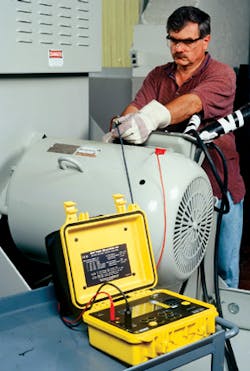Insulation resistance testing is a simple yet critical preventive measure that can significantly lower your maintenance costs.
You may be familiar with the role insulation resistance testing plays in cable maintenance, but do you realize it can help you prevent untimely motor failures, too? Not only is motor insulation susceptible to excessive temperature, moisture, dirt, corrosive vapors, vibration, oil, and aging, but it must also survive spikes from VFDs and normal inrush current. A consistent insulation resistance testing program provides considerable savings and increases uptime.
Testing also reduces maintenance resource waste. For example, a stamping and assembly plant replaced a 250-hp motor in its plant air system with a rewound motor it purchased from a local shop. After wrestling the motor into place, terminating the connections, and coupling and aligning it, the maintenance crew tried to start the motor, but it wouldn't respond. The motor service shop had mistakenly shipped a similar model that still needed to be rewound. The maintenance crew could have prevented the resulting delay and loss of production with a simple insulation resistance test as a condition of accepting the motor.
Automated vs. manual testing.
Automated insulation resistance tests save you money, but they don't eliminate the need for manual tests. For example, you should conduct insulation resistance tests when you receive motors. Any time you take your motor out of service, you should test the windings before re-terminating the motor leads. If you're conducting maintenance with the power down, you're best option is a manual test.
Whether your results come from automated or manual tests, you'll want to store the data and produce trend charts. Automate this process as much as possible — use a CMMS or similar software. Use results only from tests performed at the same test voltage for the same period, and under similar temperature and humidity conditions.
Test voltages.
Today, most megohmmeters use DC voltage. Key advantages of DC testing include smaller, lighter test equipment, nondestructive testing, and compilation of historical data.
Test AC voltages at twice the nameplate voltage plus 1,000V. When using DC voltage — common on today's megohmmeters — test at twice the nameplate voltage. The Table (right) gives you recommended test voltages. However, it's still a good idea to contact the manufacturer for its test voltage recommendations.
Test connections.
Before testing, ground the starter terminal, frame, and motor shaft. If you're testing a DC motor, lift the brushes out. Discharge the field winding by grounding. Then remove the field winding from ground and connect to the (-) line connection on the megohmmeter. Connect the (+) earth terminal to ground. You should also measure the stator winding in a similar manner.
Spot reading test.
Conduct this test only when the winding temperature is above the dew point. Connect the megohmmeter across the insulation of the windings. Apply a test voltage for a fixed period (usually 60 sec). Then take your reading. Use the same duration for all tests for comparable results.
Spot reading is meaningful only when you compare results to stored trends developed from previous tests. A downward trend usually indicates a loss of insulation resistance caused by unfavorable conditions like humidity, dust accumulation, and oil penetration. A sharp drop indicates an insulation failure.
Dielectric absorption test.
This test compares absorption characteristics of good insulation to those dampened by humidity. During the test, apply a test voltage for an extended period, usually 10 min. Take a reading every 10 sec for the first minute and one per minute for the next nine minutes. Then you can create a trend graph of insulation resistance value over time.
The slope of the curve indicates the condition of the insulation under test. Good insulation will show a continual increase in resistance, as shown in Curve D in the Figure (right). Contaminated, moist, or cracked insulation will produce a curve similar to Curve E.
Find the polarization index (PI) by dividing the value from the 10-min reading by that of the 1-min reading. This index indicates the slope of the curve. A low PI usually indicates excessive moisture and contamination. On large motors or generators, values as high as 10 are common.
Step voltage test.
Apply two or more test voltages in steps. The recommended ratio for the steps is 1:5. At each step, apply the test voltage for the same length of time, usually 60 sec. This creates electrical stresses on internal insulation cracks. This can reveal aging and damage in relatively dry and clean insulation that might not be apparent at lower voltages.
Compare the readings taken at different voltage levels, looking for any excessive reduction in insulation resistance values at the higher voltage levels. Insulation that's dry, clean, and undamaged should provide roughly the same resistance values despite changes in test voltage levels. Resistance values that decrease substantially when tested at higher voltage levels indicate insulation quality may be deteriorating.
Many people choose not to conduct insulation resistance tests because they fear they will damage the insulation, but this simply isn't true. By testing your motors at regular intervals, you'll be able to correct an impending failure before it wreaks havoc on production.
Olobri is a product development manager for AEMC Instruments, Foxborough, Mass.
